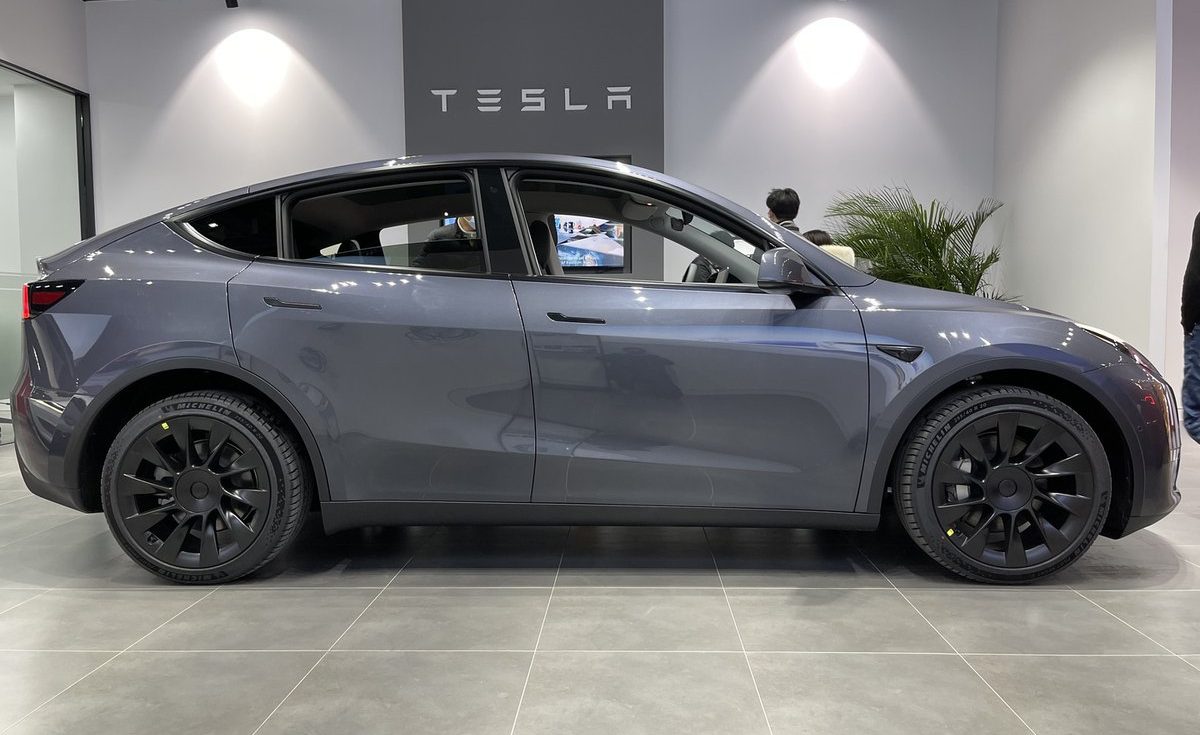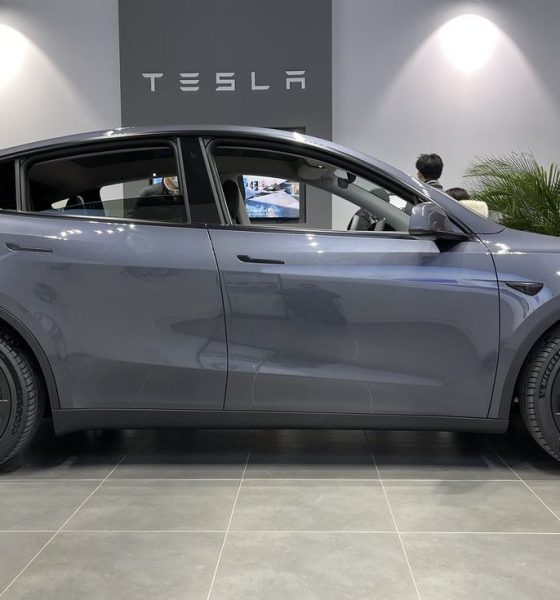

Investor's Corner
Tesla China’s Model Y Standard Range rollout brings upside to suppliers: JP Morgan
Tesla’s recent rollout of the Model Y Standard Range variant in China is bringing on critiques of positivity from some investment firms, including JP Morgan, who believes the introduction of the new crossover configuration will lead to upside for not only the automaker but its suppliers as well.
On July 8th, Tesla China officially launched the Made in China Model Y Standard Range Rear Wheel-Drive variant. With a competitive price of ¥276,000, Tesla can expect drastic amounts of demand for the company’s (likely) most popular vehicle. The Model Y has seemed to overtake the Model 3 in terms of popularity in some regions, especially because of its pricing, cargo space, performance specifications. The Model Y SR’s anticipated range ratings, which currently sit at 326 miles (525 kilometers), only add additional hype for the highly-anticipated configuration of the crossover.
Tesla Model Y Standard Range lives on in China — and it’s priced to kill
Tesla already offered the Long Range Dual Motor and Performance variants of the Model Y in China, which were both competitively priced and among the country’s most purchased vehicles. The Model Y officially overtook the Model 3 in terms of sales in May 2021, eclipsing its sibling vehicle by over 3,500 units, according to Chinese Passenger Car Association (CPCA) figures.
Because of the introduction of this new and demand-heavy variant, JP Morgan analysts Rebecca Wen, Nick Lai, Anqui Hu, and Jiajie Shen wrote a note to investors, indicating the vehicle could lead to “upside to battery and parts supply chain.” The introduction of the new variant already has JP Morgan expecting a drastic increase in production volume.
The analysts wrote:
“With this competitive offering, we believe Tesla Shanghai’s production volume (domestic sales and exports) will continue to ramp from the current ~33k units/month toward potentially 40k-60k units/month by year-end.”
Tesla’s production volumes in Shanghai have been increasing steadily as the company expanded the plant. After Model Y production began, the company started exporting some units to Europe, where demand for Tesla’s vehicles continues to grow. The note also highlights the Model Y’s competitive nature in China, as it is only eclipsed by the HongGuang Mini EV, a vehicle that is highly affordable due to its lack of standard features and also is apart of a different vehicle segment.
As demand continues to increase, JP Morgan said in the note that Tesla’s suppliers are also sitting in a good position, as they will benefit from the new Model Y launch. “While we see a high chance of a technical pullback following the rally, we believe the supply chain may trade3 at higher levels by end-2021 as underlying fundamentals continue to beat our estimates, including top-line volume (potential pent-up demand in 2H21) and margins (given the scale and stabilizing material prices.) Tesla supply chain players that may meaningfully benefit from the new Model Y launch include Tuopu (OW) and CATL (OW) and materials suppliers such as Putailai (OW).”
JPMorgan on Tesla ??
“With this competitive offering (model Y LFP), we believe Tesla Shanghai’s production volume (domestic sales and exports) will continue to ramp from the current ~33k units/month toward potentially 40k-60k units/month by year-end.”$TSLA pic.twitter.com/5DOFTNs5Jd
— David Tayar (@davidtayar5) July 9, 2021
Disclosure: Joey Klender is a TSLA Shareholder.

Investor's Corner
Tesla stock closes at all-time high on heels of Robotaxi progress

Tesla stock (NASDAQ: TSLA) closed at an all-time high on Tuesday, jumping over 3 percent during the day and finishing at $489.88.
The price beats the previous record close, which was $479.86.
Shares have had a crazy year, dipping more than 40 percent from the start of the year. The stock then started to recover once again around late April, when its price started to climb back up from the low $200 level.
This week, Tesla started to climb toward its highest levels ever, as it was revealed on Sunday that the company was testing driverless Robotaxis in Austin. The spike in value pushed the company’s valuation to $1.63 trillion.
Tesla Robotaxi goes driverless as Musk confirms Safety Monitor removal testing
It is the seventh-most valuable company on the market currently, trailing Nvidia, Apple, Alphabet (Google), Microsoft, Amazon, and Meta.
Shares closed up $14.57 today, up over 3 percent.
The stock has gone through a lot this year, as previously mentioned. Shares tumbled in Q1 due to CEO Elon Musk’s involvement with the Department of Government Efficiency (DOGE), which pulled his attention away from his companies and left a major overhang on their valuations.
However, things started to rebound halfway through the year, and as the government started to phase out the $7,500 tax credit, demand spiked as consumers tried to take advantage of it.
Q3 deliveries were the highest in company history, and Tesla responded to the loss of the tax credit with the launch of the Model 3 and Model Y Standard.
Additionally, analysts have announced high expectations this week for the company on Wall Street as Robotaxi continues to be the focus. With autonomy within Tesla’s sights, things are moving in the direction of Robotaxi being a major catalyst for growth on the Street in the coming year.
Elon Musk
Tesla needs to come through on this one Robotaxi metric, analyst says
“We think the key focus from here will be how fast Tesla can scale driverless operations (including if Tesla’s approach to software/hardware allows it to scale significantly faster than competitors, as the company has argued), and on profitability.”

Tesla needs to come through on this one Robotaxi metric, Mark Delaney of Goldman Sachs says.
Tesla is in the process of rolling out its Robotaxi platform to areas outside of Austin and the California Bay Area. It has plans to launch in five additional cities, including Houston, Dallas, Miami, Las Vegas, and Phoenix.
However, the company’s expansion is not what the focus needs to be, according to Delaney. It’s the speed of deployment.
The analyst said:
“We think the key focus from here will be how fast Tesla can scale driverless operations (including if Tesla’s approach to software/hardware allows it to scale significantly faster than competitors, as the company has argued), and on profitability.”
Profitability will come as the Robotaxi fleet expands. Making that money will be dependent on when Tesla can initiate rides in more areas, giving more customers access to the program.
There are some additional things that the company needs to make happen ahead of the major Robotaxi expansion, one of those things is launching driverless rides in Austin, the first city in which it launched the program.
This week, Tesla started testing driverless Robotaxi rides in Austin, as two different Model Y units were spotted with no occupants, a huge step in the company’s plans for the ride-sharing platform.
Tesla Robotaxi goes driverless as Musk confirms Safety Monitor removal testing
CEO Elon Musk has been hoping to remove Safety Monitors from Robotaxis in Austin for several months, first mentioning the plan to have them out by the end of 2025 in September. He confirmed on Sunday that Tesla had officially removed vehicle occupants and started testing truly unsupervised rides.
Although Safety Monitors in Austin have been sitting in the passenger’s seat, they have still had the ability to override things in case of an emergency. After all, the ultimate goal was safety and avoiding any accidents or injuries.
Goldman Sachs reiterated its ‘Neutral’ rating and its $400 price target. Delaney said, “Tesla is making progress with its autonomous technology,” and recent developments make it evident that this is true.
Investor's Corner
Tesla gets bold Robotaxi prediction from Wall Street firm
Last week, Andrew Percoco took over Tesla analysis for Morgan Stanley from Adam Jonas, who covered the stock for years. Percoco seems to be less optimistic and bullish on Tesla shares, while still being fair and balanced in his analysis.

Tesla (NASDAQ: TSLA) received a bold Robotaxi prediction from Morgan Stanley, which anticipates a dramatic increase in the size of the company’s autonomous ride-hailing suite in the coming years.
Last week, Andrew Percoco took over Tesla analysis for Morgan Stanley from Adam Jonas, who covered the stock for years. Percoco seems to be less optimistic and bullish on Tesla shares, while still being fair and balanced in his analysis.
Percoco dug into the Robotaxi fleet and its expansion in the coming years in his latest note, released on Tuesday. The firm expects Tesla to increase the Robotaxi fleet size to 1,000 vehicles in 2026. However, that’s small-scale compared to what they expect from Tesla in a decade.
Tesla expands Robotaxi app access once again, this time on a global scale
By 2035, Morgan Stanley believes there will be one million Robotaxis on the road across multiple cities, a major jump and a considerable fleet size. We assume this means the fleet of vehicles Tesla will operate internally, and not including passenger-owned vehicles that could be added through software updates.
He also listed three specific catalysts that investors should pay attention to, as these will represent the company being on track to achieve its Robotaxi dreams:
- Opening Robotaxi to the public without a Safety Monitor. Timing is unclear, but it appears that Tesla is getting closer by the day.
- Improvement in safety metrics without the Safety Monitor. Tesla’s ability to improve its safety metrics as it scales miles driven without the Safety Monitor is imperative as it looks to scale in new states and cities in 2026.
- Cybercab start of production, targeted for April 2026. Tesla’s Cybercab is a purpose-built vehicle (no steering wheel or pedals, only two seats) that is expected to be produced through its state-of-the-art unboxed manufacturing process, offering further cost reductions and thus accelerating adoption over time.
Robotaxi stands to be one of Tesla’s most significant revenue contributors, especially as the company plans to continue expanding its ride-hailing service across the world in the coming years.
Its current deployment strategy is controlled and conservative to avoid any drastic and potentially program-ruining incidents.
So far, the program, which is active in Austin and the California Bay Area, has been widely successful.








